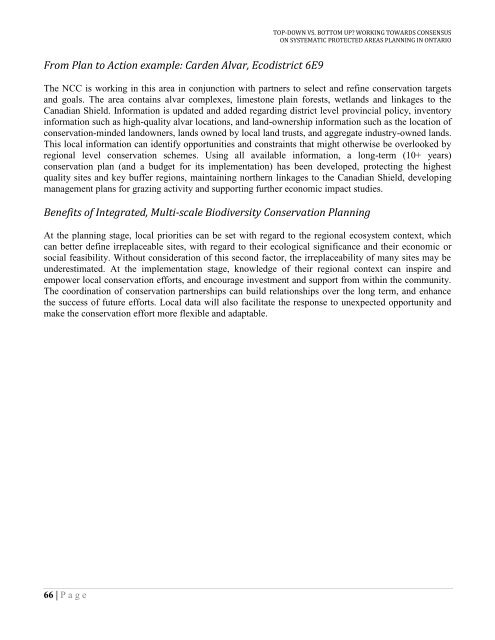Top-Down vs. Bottom Up: Working Towards Consensus ... - CASIOPA
Top-Down vs. Bottom Up: Working Towards Consensus ... - CASIOPA
Top-Down vs. Bottom Up: Working Towards Consensus ... - CASIOPA
- No tags were found...
Create successful ePaper yourself
Turn your PDF publications into a flip-book with our unique Google optimized e-Paper software.
TOP-DOWN VS. BOTTOM UP? WORKING TOWARDS CONSENSUSON SYSTEMATIC PROTECTED AREAS PLANNING IN ONTARIOFrom Plan to Action example: Carden Alvar, Ecodistrict 6E9The NCC is working in this area in conjunction with partners to select and refine conservation targetsand goals. The area contains alvar complexes, limestone plain forests, wetlands and linkages to theCanadian Shield. Information is updated and added regarding district level provincial policy, inventoryinformation such as high-quality alvar locations, and land-ownership information such as the location ofconservation-minded landowners, lands owned by local land trusts, and aggregate industry-owned lands.This local information can identify opportunities and constraints that might otherwise be overlooked byregional level conservation schemes. Using all available information, a long-term (10+ years)conservation plan (and a budget for its implementation) has been developed, protecting the highestquality sites and key buffer regions, maintaining northern linkages to the Canadian Shield, developingmanagement plans for grazing activity and supporting further economic impact studies.Benefits of Integrated, Multi-scale Biodiversity Conservation PlanningAt the planning stage, local priorities can be set with regard to the regional ecosystem context, whichcan better define irreplaceable sites, with regard to their ecological significance and their economic orsocial feasibility. Without consideration of this second factor, the irreplaceability of many sites may beunderestimated. At the implementation stage, knowledge of their regional context can inspire andempower local conservation efforts, and encourage investment and support from within the community.The coordination of conservation partnerships can build relationships over the long term, and enhancethe success of future efforts. Local data will also facilitate the response to unexpected opportunity andmake the conservation effort more flexible and adaptable.66 | P a g e


